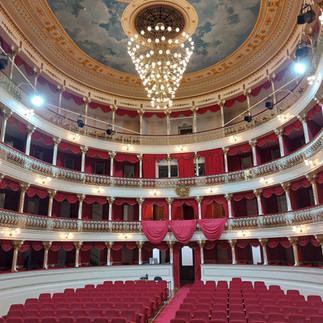Baltazar Dias Theater’s history and its secrets
- ARTE.M

- Jun 14, 2023
- 2 min read
Updated: Aug 8, 2023
It was a great day!!! For the first time, the team of our ARTHubMadeira and young artsy people from our SUMMER ART RESIDENCY had the opportunity and privilege to visit the Teatro Baltazar Dias AND the backstage.
For those who live in art, music, theater, being on the stage of Baltazar Dias Theater is a special privilege. Just look at this majesty and beauty of this historical place. And we succeeded....together with super talented musicians and singers from Bulgaria "Hristina Morfova" National School of Music and Performing Arts"

Thanks to our guide, Sara, who explained everything to us and kindly answered our questions, we learned more about its history and operation mode.
You may not know that this theater is not the first one on the island; actually, it succeeded the Teatro Grande, which was demolished in 1833 .Inspired by Italian style, the Teatro Baltazar Dias follows the same prototypes as La Scala di Milano, but also as the Teatro de São Carlos in Lisbon.These specific features required the talent and knowledge of workers such as Luigi Manini, an Italian architect and set designer, and Eugénio Cotrim, who was responsible for decorations and scenography.
In 1888, on March 11, the theater opened its doors for the very first time, named "Teatro Maria Pia" introducing the exhibition "Las Dos Princesas" from a Spanish company.But it was only in 1935, after being renamed "Teatro Manuel de Arriaga" in 2010, that Fernão de Ornelas, an old Portuguese politician, decided to rename the theater "Baltazar Dias" to honor Madeira's 21st century playwright and poet. Often called the "nationalizer of European novels", "Auto de Santa Catarina" and "Conselhos para Bem Casar" are two of its successful works of art.
We feel extremely lucky to have been able to explore the extraordinary architecture and design of this historic, artistic, and magical place, from the red seats and gold ornaments to the chandelier with more than 128 lights and the magnificent ceiling paintings of the romantic era.

We also had the chance to go up on the stage and see all the backstage things, such as the sets, mechanical systems, lights.. and of course we felt like prima ballerinas and opera singers doing a show in front of hundreds of people. We can mention the vertical stairs, which allow us to see inside the theater from above, all hidden, but attention: if you are afraid of heights, don’t take those stairs.

Thank you to Teatro Baltazar Dias’s team for their availability and kindness towards us, and if you have never visited this place, this is your sign to go!
By Chiara Schweitzer























Comments